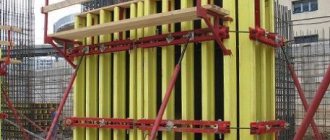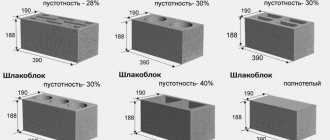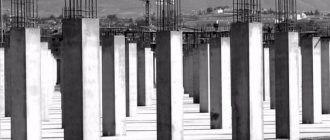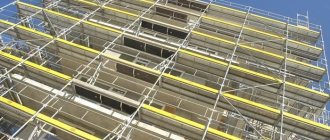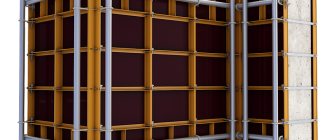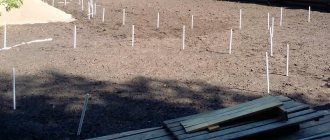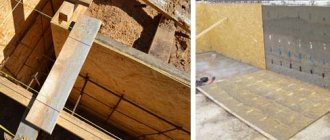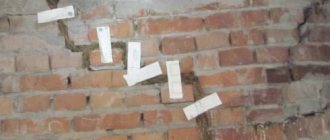Permanent formwork for foundations - advantages
Fixed polystyrene foam formwork has the following properties:
- the production of permanent formwork from polystyrene foam makes it possible to obtain inexpensive material suitable for the needs of private construction;
- ease of installation;
- high strength characteristics. Foundation formwork can withstand the pressure of concrete when pouring;
- When using polystyrene foam blocks, the construction cost of the foundation is reduced. The material has excellent thermal insulation properties, which eliminates the need for additional layers, resulting in energy savings;
- fire safety;
- subject to installation rules, work is carried out as soon as possible;
- small mass of blocks;
- moisture resistance;
- tightness;
- soundproofing;
- environmental Safety;
- decent ratio of cost and quality characteristics.
A house made of permanent polystyrene foam formwork can be erected by any home craftsman, even with non-professional skills and experience
Universal screed for permanent formwork - TECHNONICOL
Application area:
- formwork of walls and foundations from various materials;
- formwork of lintels over openings;
- formwork of columns, armored belts and grillage.
Description:
A universal screed is a fastener designed to reliably connect the formwork walls to each other. It is used in the construction of prefabricated monolithic buildings and structures (including walls and foundations) using permanent formwork technology. The universal formwork tie is used to connect formwork sheets with a thickness of 10 to 125 mm in increments of 5 mm. As sheet material, it is possible to use:
- extruded polystyrene foam TECHNONICOL CARBON
- low-density insulation in combination with other building materials (SML, OSB, plywood, fiberboard, etc.)
When using a universal screed, it is possible to make formwork to form a concrete core with a thickness of 100 to 250 mm in increments of 25 mm, and with an extension from 400 to 550 in increments of 25 mm.
Advantages of using a universal formwork screed:
- low cost and the ability to combine formwork and insulation in one product
- high speed, accuracy and ease of formwork assembly
- the ability to choose any sheet material of sufficient strength and moisture resistance as formwork walls
- absence of cold bridges in the finished structure
- no formwork dismantling work
- high tensile strength with low weight and inertness to building materials
- ability to choose the thickness of the concrete and formwork parts, as well as the protective layer
The main elements of a universal screed for permanent formwork.
At one end of the universal screed there is a rod that has a special groove for installing fastening locks. Along the edges of the screeds there are embedded reinforcement bars, with the help of which it is possible to adjust the protective layer of concrete from 30 to 70mm. The connection between the ties is ensured by a special fastening
Material of universal formwork screed: non-flammable, frost-resistant, impact-resistant plastic.
1-universal tie 2-mortgage for reinforcement 3-extension 4-lock
Specifications:
| Indicator name | Meaning |
| Thickness of sheet formwork materials, mm | 10-100 (in 5 mm increments) |
| Concrete core thickness, mm | 100-250 (in 25 mm increments) |
| Tensile strength, N | ~2450 |
| Weight of one tie, kg | 0,07 |
| Quantity per package, pcs | 150 |
Stages of installing permanent formwork
| Step 1. Make markings in sheet material (CBPB, plywood, OSB) and drill a Ø12mm hole |
| Step 2. Install the reinforcement clamp on the universal screed at the required distance (30, 50 or 70 mm) to provide a protective layer. |
| Step 3. Install the universal formwork tie into the hole with the reinforcement clamp facing up. |
| Step 4. Press the lock tightly to the sheet and secure the universal formwork tie to the sheet. Place the lock on the rod and press down until it stops. |
| Step 5. Attach the universal screed to the XPS TECHNONICOL CARBON slab by piercing the slab with a rod. Install a lock on the back of the insulation board (see step 4). |
| Step 6. Fasten both ties, aligning the locks of the mating parts. The embeds for the reinforcement should be on one side of the screed from above. |
| Step 7 Install and tie the reinforcement cage inside the formwork. Lay the longitudinal rods of the frame on the mortgages under the reinforcement. |
| Step 8 Pour the concrete mixture with vibration compaction. |
Booklet
Polystyrene foam formwork system, production
The production of blocks can take place according to the following methods:
- foundry – is distinguished by efficiency and manufacturability. The resulting blocks are characterized by a high-quality surface. The amount of waste is reduced to a minimum;
- cutting out.
Technological stages of the foundry method:
- pre-foaming - the material undergoes a single treatment with water steam. The granules expand in volume and reach a density of 25-35 kg/m³;
- keeping the foamed material in a ripening bunker, when the condition of the granules stabilizes, they get rid of excess moisture. Duration of ripening – 12-24 hours;
- block molding - block molds are used where repeated foaming occurs. The block, cooled with water, can be removed;
- exposure - the stage lasts 12-24 hours. The final time depends on the humidity and temperature of the room where the work is being carried out;
- crushing waste and transferring it to a storage facility. The remaining material can be reused, but in an amount not exceeding 3% of the total volume.
Production of permanent formwork from polystyrene foam, equipment
To organize a mini-line, it is necessary to prepare a room of 40-60 m². In private construction, it is easy to organize the production of permanent formwork from polystyrene foam with your own hands.
How to choose equipment?
Steam accumulator/steam generator. The choice should be based on the following characteristics :
- t during foaming – 100-115°;
- t during molding – 130-140°;
- steam pressure at the foaming stage – 1-1.5 Atm;
- steam pressure during molding – 4-5 atm;
- steam consumption at the foaming stage – 50-100 kg/h;
- steam consumption during molding is 25-50 kg/h.
It is recommended to install the steam generator together with a steam accumulator, otherwise higher power equipment will be required. When foaming, the material must suffer a “thermal shock”.
Fixed polystyrene foam formwork, photos and videos of which are present in any construction publication, is a modern and ergonomic solution for private construction
Pre-expander:
- if maximum automation of the process is necessary, it is recommended to purchase an appropriate dispenser and a device for supplying raw materials, but manual control is cheaper;
- You can choose a device with a built-in steam generator.
Ripening bin:
- the device allows you to control the volume of foam granules and is necessary for drying them;
- Heated air is continuously supplied to the bunker.
Block forms:
- for construction it is necessary to select those components that are designed for the production of permanent formwork from expanded polystyrene;
- the master can use H-shaped or U-shaped blocks;
- it’s good if they are made of metal and there are taps for draining condensate and relieving excess pressure.
You will also need pneumatic transport, a control unit, a waste crusher, a receiving hopper for the pre-foamer and some components.
Average performance allows you to get 100-300 blocks at a time . The full production cycle of one block takes no more than two minutes. Using such equipment, you can make permanent formwork from polystyrene foam with your own hands.
Types of permanent formwork
Permanent formwork must have the following qualities:
- low cost, otherwise its use will become economically unfeasible;
- strength sufficient to withstand the bursting effect of the liquid concrete mixture;
- durability;
- ease of installation.
Elements of permanent formwork are produced in two types:
- volumetric elements of unchangeable shape and size, defining strictly defined geometric characteristics of the future foundation (in particular, width);
- separate elements that allow you to arbitrarily change the dimensions of the foundation strip by assembling formwork of various widths and heights.
Depending on the raw materials used in production, permanent formwork is divided into several types.
Types depending on raw materials:
- from cement-bonded particle boards;
- from fiberboard;
- from wood concrete;
- from expanded polystyrene.
Products made from expanded polystyrene have recently become very popular among private developers, including not only when pouring foundations, but also as formwork for erecting walls.
Fixed polystyrene foam formwork, dimensions
The size of permanent polystyrene foam formwork is indicated in the table data.
| Foam formwork – name | Options | Thermal insulation thickness | |
| internal | external | ||
| Episode 25 | |||
| Main/end wall block | 250.0x250.0x1250.0 | 50.0 | 50.0 |
| Corner wall block (left/right) | 250.0x250.0x700.0 or 250.0x250.0x500.0 | 50.0 | 50.0 |
| Episode 30 | |||
| Main/end wall block | 250.0x300.0x1250.0 | 50.0 | 100.0 |
| Corner wall | 250.0x300.0x1250.0 or 250.0x300.0x500.0 | 50.0 | 100.0 |
| Episode 35 | |||
| Wall block | 250.0x300.0x1200.0 | 50.0 | 100.0 |
| Episode 50 | |||
| Main/end block | 500.0x300.0x1250 | 50.0 | 100.0 |
| Corner block | 500.0x300.0x450.0 or 500.0x300.0x650.0. | 50.0 | 100.0 |
A foundation made of permanent polystyrene foam formwork can be erected in harsh climatic conditions
How to assemble the system?
The technology of work is as follows:
- the base is covered with waterproofing material;
- reinforcing bars are driven in;
- the distance between the rows is selected based on the calculations performed;
- blocks are put on reinforcing bars;
- the first layer is fixed - horizontal reinforcement is placed in special grooves;
- the connection is made with overlapping wire twists;
- at this level there are outlets for door slopes and internal partitions;
- the shape of the permanent formwork is fixed when laying out the second layer of blocks, ensuring that the seams overlap;
- the coincidence of the sides of each layer is monitored, while the row is shifted to ensure overlap of the seams;
- this process is reminiscent of brickwork;
- The blocks are fixed vertically using grooves. To close, just apply light pressure;
- the third layer is laid, the vertical seams are leveled;
- concrete is being poured;
- the solution is compacted with a deep vibrator or a piece of reinforcement;
- It is better to fill the last blocks by ½ - the seam will be inside the block and the walls will be stronger.
Cost and calculation of construction
Permanent formwork made of polystyrene foam (prices available to any builder) allows you to create economical buildings. To illustrate such savings, you can make an approximate calculation.
Permanent formwork made of polystyrene foam price/calculation for walls, m²:
- it is necessary to buy permanent formwork at the rate of 3.3 pcs/m² ̴ 495 RUR;
- concrete pouring – 0.15 m² – approximately 125 l – current price for the material;
- reinforcement - up to 10 kg/m² - current price for the material.
If you buy permanent formwork made of polystyrene foam, the price for the construction of one floor will be as follows:
- total S walls minus window and door openings (10*10 m – 40 m)*3 m = 180 m²;
- polystyrene foam formwork price – 180 m² * 490 RUR = 88,200 RUR;
- price for concreting – 180 m²*0.15 m³ = 3000 rubles*27 m³ = 81 tr;
- reinforcement – 180 m²* 10 kg = 1.8 t/21 t.r = 37.8 t.r.
Total cost – 207 TR – 1150 RUR/m² (permanent formwork (price) + reinforcement + concrete).
What is more profitable to buy formwork or make it yourself?
If a private builder himself produces formwork from extruded polystyrene foam for the foundation, the price consists of the cost of equipment, raw materials and resources:
- steam/water, electricity – depends on the region;
- foaming suspension polystyrene – from 350 RUR/100 l;
- set of equipment – from 450 tr.
In order not to bother with manufacturing, it is recommended to take ready-made blocks for permanent formwork, which will not be difficult to buy
The average cost of blocks manufactured on our own equipment is 310 rubles/m² . If it were necessary to equip a wall with an area of 180 m², the cost would be 55.8 thousand rubles. It is cheaper than using purchased material.
However, it is impossible to achieve full payback when constructing single buildings . The benefit can only be obtained if a private builder plans to build several houses in the long term using the “warm house” system, that is, all structures will be built on permanent formwork.
Feasibility of application
The idea of using permanent formwork seems very exciting, but is it always advisable to use this particular method of constructing a foundation?
There are many opinions on this matter. Some people, having tried this option, become its ardent supporters and popularizers. Others find good reasons to use other formwork options, including permanent formwork.
So, when is it still worth using PPS blocks as formwork?
As we see it, these could be the following options:
- Construction of a standard foundation for a not too large private house. If the building is large and heavy, the costs of purchasing and assembling permanent formwork can be quite substantial, while ordinary wooden formwork can be removed after completion of the work and the lumber can be used for other purposes.
- When building a foundation in winter, foam plastic is an excellent help - its thermal insulation characteristics will reduce the cost of heating the concrete to gain strength several times. And if the foundation is not too voluminous, then they will allow you to do without heating at all (since a sufficient amount of heat is released when the concrete hardens).
- When constructing a building without a basement. In the case of a basement in use, it is better to use permanent formwork of a combined type - on the outside of the foundation there is a wall made of PPS, and on the inside there is a cement-bonded particle board that is safe for health.
In other cases, before deciding to use permanent formwork, it is always worth carefully considering the economic and environmental feasibility of its use.
